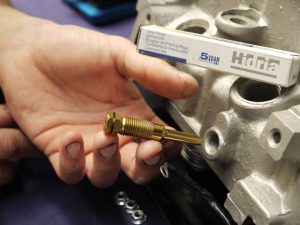ULTIMATE GUIDE ABOUT GLOW PLUGS

How does a diesel engine work?
Diesel engines use internal combustion. In other words, fuel is introduced into a combustion chamber and then ignited. High compression heats the fuel to its ignition point, whereas a gasoline engine uses a spark plug to ignite a mixture of fuel and air.
Like a gasoline engine, a diesel engine uses a 4-stroke combustion cycle:
- As the piston moves down, air enters the cylinder. (1st stroke)
- Air is compressed as the piston moves back up (it heats up to 700-900°C) (2nd stroke).
- As the piston reaches the top of the cylinder, diesel fuel is injected and ignites, which results in an explosion forcing the piston back down. (3rd stroke).
- After this, the piston moves up again, pushing the exhaust gases into the exhaust system (4th stroke).
Diesel engines were once considered very inconvenient and primarily for agricultural purposes. Those days are long gone. The technology behind ignition systems and glow plugs has advanced significantly. Diesel engines are far cleaner, quieter, and more efficient nowadays.
Cold start – What does it mean?
The term “cold start” refers to when a diesel engine and its fluids are exposed to cold temperatures, e.g. below 5°C. The engine isn’t yet at its optimal temperature. Low temperatures make diesel engines harder to start. Therefore, glow plugs are crucial for every cold start. They warm up the engine combustion chamber to a sufficient temperature to create the ideal ignition conditions for the injected fuel. A glow plug not only provides the necessary energy for efficient combustion, but today’s low voltage systems also compensate for low or weak battery performance.
Glow plugs and their role today
The main function of the glow plug is to provide an ignition aid at the start. However, stricter emission regulations brought new challenges to the automotive industry. Glow plug technology plays a key role here as well. The goal is no longer just to reduce the heat-up time of the engine, but also to improve fuel consumption, reduce soot, and lower emissions into the air we breathe.
The future of the diesel engine requires innovative and resource-efficient solutions. Dedicated Research & Development teams in HIDRIA are working closely with the leading OE global automotive manufacturers to meet the ever-demanding trends. With its innovative solutions and advanced technologies, HIDRIA is one of the leading suppliers of diesel cold start systems, especially glow plugs.
Modern glow plugs should meet the following requirements:
- Ability to withstand extreme conditions (extreme heat, high pressure, vibrations, and corrosive chemicals)
- An extremely short pre-heating time
- A high service life
- Small space requirement (with modern diesel engines, the space requirement for a glow plug is minimized)
- Perfect fit for a combustion chamber
- Reduced exhaust emissions
- Reduced load on the vehicle electrical system
Bonus: Discover the latest generation of glow plugs – Glow plug with a pressure sensor.
How do glow plugs work?
Pre-heating phase
The pre-heating system supplies the additional heat energy that is required for a clean and successful cold start.
Just before starting the engine, a voltage is applied to the terminal of the glow plug and the current flows through the heater and regulator coil. The glow plug is heated to its operating temperature and the heat energy is being transferred to the protective sheath causing it to glow.
Different engine designs require different times to reach a temperature suitable for stable combustion.
Post-heating phase
The glow plugs continue glowing after start-up to reduce the amount of white or blue smoke produced and maintain good idle stability until the engine is sufficiently warm. The post-heating phase depends on the engine temperature, driving mode, and other environment conditions.
What to watch out for when you replace glow plugs?
- In most cases, excessive voltage results in glow plug failure. Check the entire electrical system before changing the glow plugs. Glow plugs can overheat if the electrical voltage is held too long, either by faulty relays or controllers. This can result in heating coil failure and melting of the heater tube.
- Be careful not to damage the plug. Remove the glow plug from the cylinder head using a socket wrench. Do it slowly and pay attention to any resistance. Don’t try and remove it with force, as you can damage the glow plug. A major mistake that could cost you money, nerves, and time.
- Clean the hole before installing glow plugs. Use a reamer set. That’s a must. You should remove any carbon deposits to keep the glow plug from failing prematurely.

- Screw the new glow plug as far as it goes by hand.
- Set the torque wrench to the correct tightening torque
| THREAD SIZE | RECOMMENDED TORQUE | |
| GLOW PLUG | M8 | 8-14 Nm |
| M10 | 15-18 Nm | |
| M12 | 20-25 Nm | |
| CONNECTION NUT | M4 | Max 2 Nm |
| M5 | Max 4 Nm |
Table: Recommended installation torque specification
- Additionally, pay attention to these two things. Insufficient tightening of the glow plug could lead to combustion gas leakage and poor electrical performance. Glow plugs can break if overtightened beyond the recommended torque.
